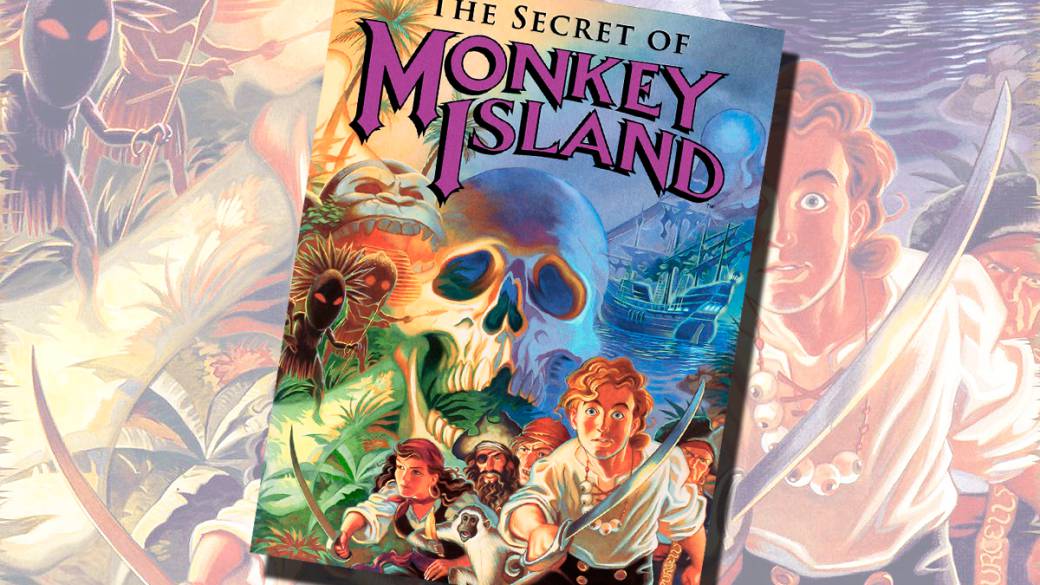
30 years ago we went through incredible adventures in our attempt to become a pirate. We had before us one of the funniest works of Lucasfilm Games.
Monkey Island has turned a staggering 30 years. If you too went on an adventure with Guybrush on his risky mission to become a sea lion, you may have a few years of seniority on you (and gray combs). You will remember the placid feeling of changing floppy disks, turning a wheel to guess when the mustache pirate died in Tortuga and knowing how to recite the composition of the grog without a cutlet. Maybe you also gained a few diopters when playing in 16 colors? Be that as it may, the Monkey Island saga holds a prominent place in our little heart as a long-suffering adventurer.
To celebrate the 30th anniversary of The Secret of Monkey Island we are going to go over a long list of design curiosities that may surprise you. Put the saucepan on your head, we start.
The true inspiration of Monkey Island
Ron Gilbert commented in an interview at that time that the Pirates of the Caribbean attraction at Disneyland was a source of inspiration for the setting. However, it was not decisive. The Secret of Monkey Island drinks directly from the novel ‘On Stranger Tides’ by Tim Power. And from there Guybrush and Elaine were born, or the importance of voodoo.
Undetermined release date
It is difficult to set a launch date, since in those days logistics had limitations. The same team had to pitch in to pack games in the warehouse on the night shift. Tim, Dave, and Ron signed a dollar bill and tossed it in a box, but they never knew who the lucky winner was. The designer places his anniversary in September, specifically on the 3rd of that month, at which time the final version was recorded on floppy disks.
Guybrush, Elaine and LeChuck’s Secret
The team used the Dpaint program to make the sprites for the characters. The file name “guy” added to the extension .brush led to our apprentice pirate Guybrush. In Elaine’s case, during early drafts she was simply listed as “the governor.” Grossman came up with a final wedding scene inspired by the movie “The Graduate,” which Ron liked so much that the governor was christened Elaine. And we ended up with LeChuck, which was a concession from Ron Gilbert to Steve Arnold, Lucasfilm’s division chief, who insisted on the name Chuck for a character in the game.
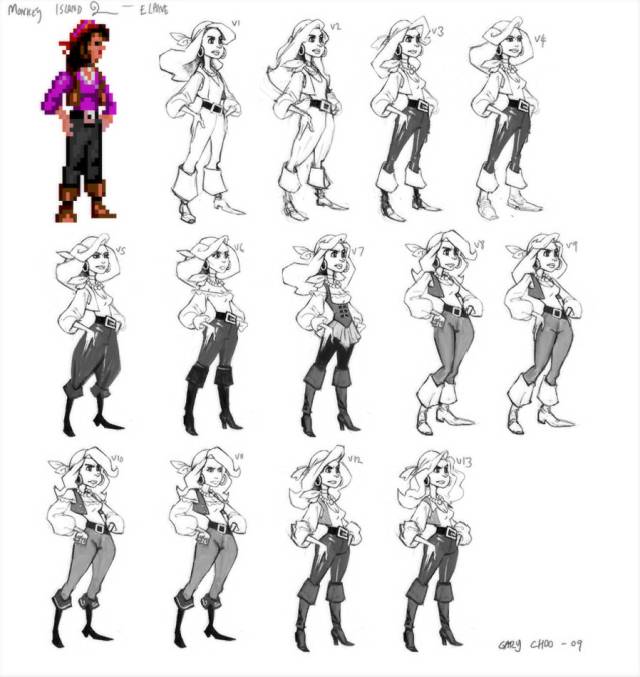
The origin of SCUMM
The software created to streamline the Maniac Mansion creation process was built on the tools used in Habitat, an MMO ahead of its time that was released in 1987. Morningstar helped Ron Gilbert create the first version of the real compiler for the SCUMM engine. Later the designer would improve and expand it based on their needs. The popular Melee Island bar is named after him.
Melee Island in real life
If you dream of visiting the island of Melee we must tell you that … it does not exist! The picturesque streets of Melee take inspiration from a section of the charming city of Rothenburg (Germany). The avenue with the clock tower is certainly traced to that of the game. Will a witch walk around to read us the future?
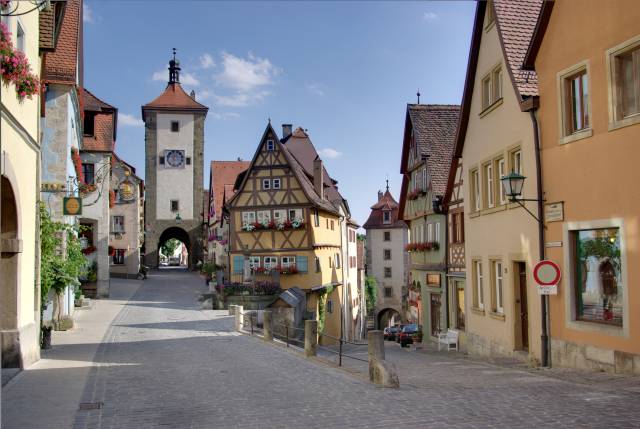
Barriers to development
Ron worked for 2 1/2 years on Monkey Island, but Indiana Jones and the Last Crusade needed reinforcements and his work had to be postponed. In 1989 the development known at that time as ‘Mutiny on Monkey Island’ was resumed. By Ron Gilbert’s election, Tim Schafer and Dave Grossman would join the team as programmers and writers. Previously, the couple were part of a junior programming group called “SCUMMlets,” but with The Secret of Monkey Island they took a big step in their career. They programmed as a draft a first version of the game where, on the fly, they invented dialogues to have a laugh. Ron saw the humorous potential in many of them and they remained in the final version. Stan’s lines appeared in that first test.
The magic of the scanner
Peter Chan was one of the artists from Monkey Island 2 who used the brand new scanner that arrived at Skywalker Ranch. His talented marker pen drawings made the leap into the game thanks to new technology, but it was something primitive that produced some artifacts. Interestingly, one of the questions to ask LeChuck while we are hung up on acid is “why do adventure games cost so much?” To which he replies: “VGA scanning art is very expensive.”
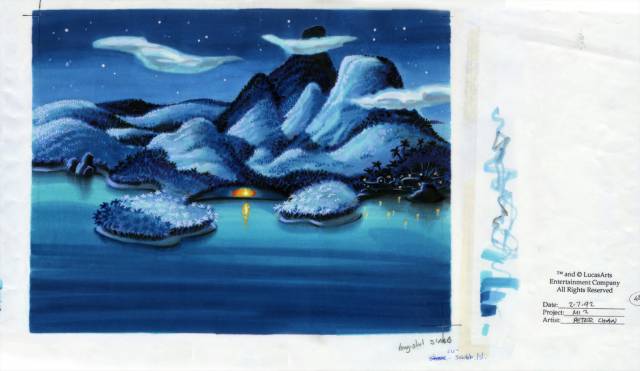
Peter Chan artwork
Dying is possible
Guybrush never tires of boasting about his ability to hold without breathing for 10 minutes. We can put it to the test when they throw us into the water with the idol and go beyond that time to see the last moments of the boy’s life. In the sequel, if he hangs on LeChuck’s trap for several minutes, Guybrush will fall into the acid. That is when the game returns to Elaine and Guybrush’s tale to correctly tell the story.
Juggling the capacity limit
The Secret of Monkey Island had to occupy 5 floppy disks, not one more, not one less. And that was totally challenging with the innovative ideas that the Lucasfilm Games team was coming up with. The Melee forest was generated randomly and such technology was not common at that time. On the other hand, the number of sprites and animations also had to be under control. There were some animations that received the category of “Special Case Animations”, that is, those for rare occasions. When Guybrush goes down the zip line with the rubber chicken with pulley it would be one of them. They had to measure which ones were really important. Monkey Island 2 went further and took up 11 floppy disks, even after suppressing scenes important to Ron Gilbert.

Ideas discarded
Thousands of ideas arise in every project that are noted and then their viability is studied during development. Ron Gilbert discarded many of them due to lack of time, or simply because they did not fit well into the whole. We missed a playable naval battle during our journey to Monkey Island at the hands of Tim (said to still have the designs). Also, Meathook was going to challenge us with 3 tests, but the pace of the adventure slowed down a lot and they had to simply leave one of courage.
Learned lessons
After passing through Maniac Mansion and Indy, Ron Gilbert began to write a manual of good practice in adventure games in order not to make the same mistakes. He titled it “Why Adventure Games Suck.” It was key to the design of Monkey Island. Available on his blog.
Ideas added
Some ideas disappear but others emerge to give life to the work. Do you remember the three important pirates of Scumm Bar? Yes, those of “THE THREE TRIALS”. Well that was an addition at the end of the design stage to ensure that the game was not so linear. In this way, the player stuck in a puzzle could move on to another without hitting the wall with his head. The Melee missions also included contact with characters who would later become part of the crew. Once on Monkey Island, the team noticed that the game was slowing down, hence the star appearance of Herman Toothroot, our castaway and tired of the year.
The premiere of iMUSE
iMuse (Interactive Music Streaming Engine) is the work of composer Michael Land. After The Secret of Monkey Island, Land saw the need to create a tool for the transition of music between events and locations to play smoothly. Peter McConnell, his fellow songwriter, joined the project and together they patented a unique system that would kick off on Monkey Island 2 and that endured through the adventures of the studio.
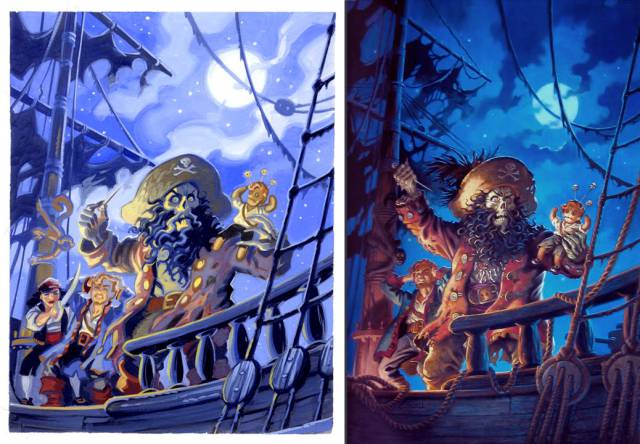
Illustration by Steve Purcell
Insult fights with a good pen
The sci-fi writer Orson Scott Card (Ender’s Game) was the author of the hilarious name-calling duels. Although he had the invaluable help of his 11-year-old son. The boy collaborated with his father and one fine day he wrote a lapidary phrase on a piece of paper: you fight like a farmer. He gave it to his father and he was surprised by the insults of the kids his age. Nonetheless, it was perfect for the funny pirate adventure.
From EGA to VGA
Monkey Island was originally released in 16 color EGA, but on Monkey Island 2 it started in 256 color VGA. In the EGA version of the original we see the sunset on the Melee Island pier, but with 256 colors it changes to the night sky. How many colors did you start with?
Team development
The development work was divided between areas and characters. Ron took over parts like the ghost ship. Instead, Dave brought good old Toothrot and low morale men to life, not forgetting his Sierra gag. For his part, Tim Schafer made us laugh with Stan and the cannibals. He was also responsible for the appearance of the 3-headed monkey.
Difficulty mode
Some versions of Monkey Island 2 allowed the player to choose between two levels of difficulty. The easy version significantly reduced the steps when solving puzzles. On the back of the box it indicated that it was intended for video game analysts. Ron Gilbert thought about adding an intermediate mode, since the easy mode was extremely simple and the normal one was the opposite, but it was finally discarded.
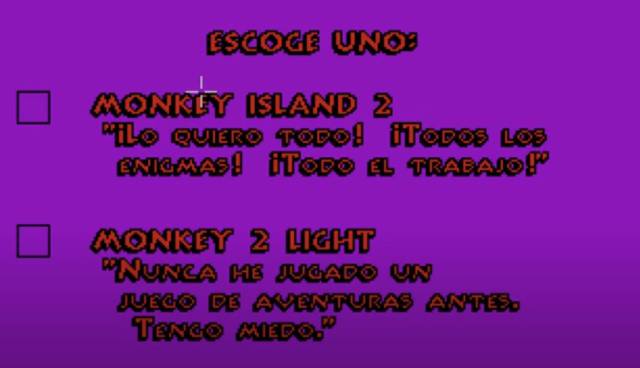
Critical success
Let’s face it, Monkey Island was never a commercial success, but it certainly garnered rave reviews, becoming over time one of the most beloved adventures ever. The team noted that the original and its sequel sold well overall, and were a hit in Europe.
If you’ve made it this far, congratulations. Now find your copy of Monkey Island, sit back, and revisit one of LucasArts’ most terrifyingly fun adventures.

